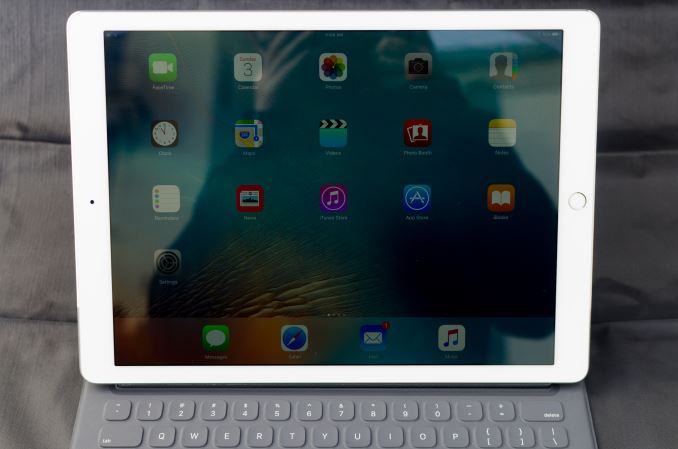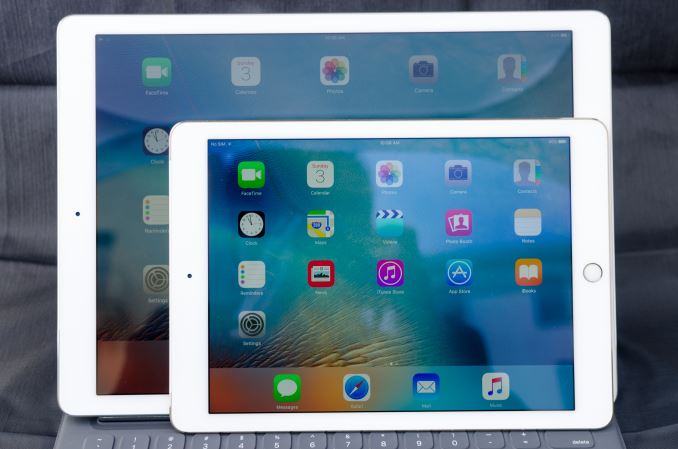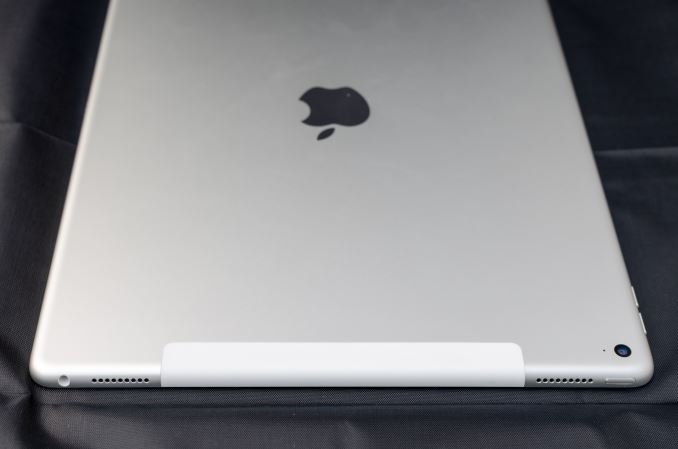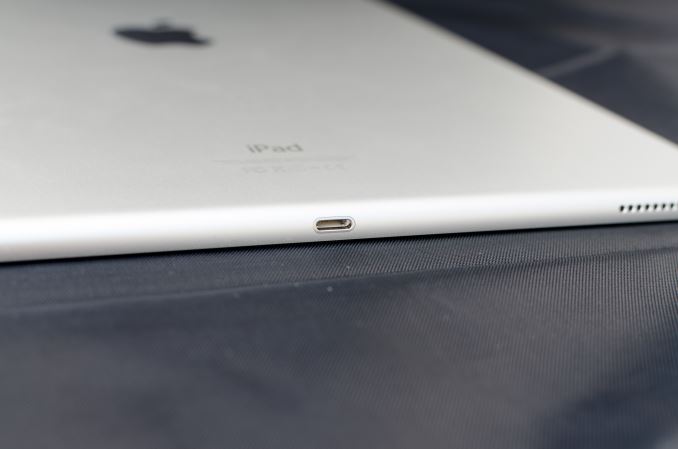The Apple iPad Pro Review
by Ryan Smith, Joshua Ho & Brandon Chester on January 22, 2016 8:10 AM EST
At this point it probably isn’t a secret that tablet sales have leveled off, and in some cases they have declined. Pretty much anywhere you care to look you’ll see evidence that the tablet market just isn’t as strong as it once was. It’s undeniable that touch-only tablets have utility, but it seems that the broader market has been rather lukewarm about tablets. I suspect at least part of the problem here is that the rise of the phablet has supplanted small tablets. Large tablets are nice to have, but almost feel like a luxury good when they’re about as portable as an ultrabook. While a compact laptop can’t easily be used while standing, or any number of other situations where a tablet is going to be better, a compact laptop can do pretty much anything a touch-only tablet can. A laptop is also going to be clearly superior for a significant number of cases, such as typing or precise pointing.
As a result, large touch-only tablets feel like they’ve been limited to home use as a computer away from the computer. Tablets are great when you’re on the couch or in bed, but once you get to this point there are some obvious questions as to whether it makes sense to drop $500+ USD on a tablet that seems to have relatively limited utility. The Surface lineup has been showing signs of growth, but in general the Surface is more of a mix between laptop and tablet rather than a tablet. I would argue that given the OS and overall design that the Surface and Surface Pro are really more laptop than tablet, even if at the hardware level the Surface Pro 4 and Surface 3 are basically tablets with kickstands and keyboard covers.
If you’re guessing that this means Apple has had some issues with growing sales of their iPad lineup, you’d be right. From my first experiences with the iPad 3, I was impressed with the improved user experience for things like web browsing and other smartphone tasks, but I never really felt like it made enough sense to get one for myself. The iPad Air 2 was once again impressive and I felt like I could recommend it to other people that wanted a tablet, but I personally struggled to come up with a reason why I would buy it.
This brings us to the iPad Pro. This is probably the first time Apple has seriously deviated from traditional iPad launches, putting together a tablet built for (limited) productivity and content creation rather than just simple content consumption, creating what's arguably the iPad answer to the Surface Pro. To accomplish this, Apple has increased the display size to something closer to that of a laptop, and we see the addition of a stylus and a keyboard cover for additional precision inputs. Of course, under the hood there have been a lot of changes as well, so the usual spec sheet can be found below to summarize those changes.
| Apple iPad Air 2 | Apple iPad Pro | |
| SoC | Apple A8X 3 x Apple Typhoon @ 1.5GHz |
Apple A9X 2 x Apple Twister @ 2.2GHz |
| GPU | PowerVR 8 Cluster Series6XT (Apple GXA6850) |
PowerVR 12 Cluster Series7XT |
| RAM | 2GB LPDDR3 | 4GB LPDDR4 |
| NAND | 16/64/128GB | 32/128GB |
| Display | 9.7" 2048x1536 IPS LCD | 12.9" 2732x2048 IPS LCD |
| Size and Mass | 240 x 169.5 x 6.1mm 437g WiFi, 444g LTE |
305.7 x 220.6 x 6.9 mm 713g WiFi, 723g LTE |
| Camera | 8MP Rear-Facing, f/2.4, 1.1 micron, 1.2MP Front-Facing, f/2.2 | |
| Battery | 27.3Wh | 38.5Wh |
| Launch OS | iOS 8 | iOS 9 |
| Cellular Connectivity | MDM9x25 Category 4 LTE + GPS/GNSS in Cellular SKU | |
| Other Connectivity | 2x2 802.11a/b/g/n/ac + BT 4.2, Apple Lightning | |
| SIM | Optional NanoSIM | |
| Price | $499/599/699 16/64/128GB | $799/949/1079 32/128GB/128GB LTE |
At a high level, the iPad Pro gains a larger display with a higher resolution, more memory, a new SoC, and a larger battery to compensate for the change in display size. In addition to these changes, the iPad Pro also brings noticeable changes to the speakers, with an increase to four speakers which allow the iPad Pro to compensate for device orientation when projecting stereo audio.
Design
The most immediate change that you can see in the iPad Pro is the sheer size. The 12.9” display of the iPad Pro basically makes it feel like you’re carrying a laptop around. I would argue that this doesn’t actually affect the portability of the iPad Pro, but this is mostly because the iPad Air 2 was something that I only carried in a backpack to begin with. People carrying their tablets in a small bag, purse, or even just in their hands will notice the difference, so the change in size might be more or less noticeable depending upon how you carry things around.
The increase in size does affect weight. After significant use, I honestly don’t think the mass is a significant issue. It does feel heavier than the iPad Air 2, but the mass distribution is such that there isn’t a ton of battery hanging out at the edges of the device where it’ll affect the moment of inertia. This does raise the question of whether Apple included enough battery for sufficient battery life, but that’s a question best left for the rest of the review.
In terms of design, the iPad Pro is rather unremarkable if you’ve ever seen an iPad Air before; it is for all intents and purposes a bigger iPad Air. On the front, the display dominates, with some bezels on the sides and top. The top has the front-facing camera, and the bottom has the home button with TouchID.
Looking at the sides of the tablet, the top edge has the power button and 3.5mm port, along with two of the four speakers. The right edge has the volume buttons, and the bottom edge has the Lightning port and the other two speakers. The left edge is mostly empty, but contains the Smart Connector for the Smart Keyboard and similar accessories.
The back of the tablet is mostly unremarkable as well. For the LTE model, an RF window is visible on the top of the device to allow LTE and other connectivity to function. For the WiFi variants, it looks like the bottom display bezel and the bottom two speakers are the RF windows, so there aren’t any visible areas that indicate where the WiFi antennas are.
Overall, the iPad Pro feels like an iPad, with nothing all that remarkable beyond its size which is carried well. I never really noticed the mass or size of the iPad Pro even if it is clearly larger and heavier than the iPad Air 2. I also didn’t notice any issues with the back cover flexing, but given enough pressure on the back cover pretty much any device this large will see some screen distortion or bending. The iPad Pro does technically regress in thickness compared to the iPad Air 2, but I never noticed the difference in practice, especially when the larger display is really what matters more.
















408 Comments
View All Comments
lucam - Friday, January 22, 2016 - link
In 2016 you guys still run the 3d Ice storm test which is really obsolete, it's a 720p an use OpenGL ES 2.0Really you will have to start using the new one Sling Shot and the new GFX bench 3.1 that now is also on IOS too.
JoshHo - Friday, January 22, 2016 - link
We're definitely aware of this issue and it's part of what we're planning on refreshing for 2016 reviews.name99 - Friday, January 22, 2016 - link
Guys you should surely be aware that libquantum is problematic as a benchmark because it can be (and is, by icc) restructured to be auto-parallelized and auto-vectorized. It's a matter of opinion the extent to which you consider this "cheating"; the more important point IMHO is that this particular transform seems very specific to the structure of libquantum and doesn't much empower icc to produce better (more frequently parallelized or vectorized) code in other circumstances.Point is libquantum is not telling us much about Twister vs Broadwell' it's telling us about icc vs LLVM.
Hmmer is similar, but less egregious. The hot loop there is amenable to some restructuring that moves some load-stores around, then runs everything as vectors replacing if's with select. This is a justifiable, more general purpose transform, which is on LLVM's to-do list, but hasn't been done yet.
icc also seem to do a remarkable job (some sort of transformation I assume, but it might be generating good software prefetching?) on mcf, but I don't know quite what that is.
This website (in French) is hardly ideal but is the best I can find for making this point:
http://www.hardware.fr/articles/847-9/performances...
Forget the exact numbers on each graph, or the AMD graphs. IMHO the point of interest for each graph is to see the cases where the icc results are dramatically different from the gcc results, (which in other words shows a benchmark which is primarily comparing LLVM vs icc, not CPU vs CPU).
mcf, hmmer, milc, lbm, show this.
This page is not ideal in that it's three years old, so gcc (and LLVM) could in theory have picked up some of icc's skill. (milc and lbm are FP benchmarks, presumably being improved by vectorization and/or parallelization; and gcc/llvm both have much better autovectorization than three years ago, though not yet autoparallelization).
Personally I think for THIS type of review (where the interest is in trying to compare Twister against Intel's latest) it would have been better to also perform an LLVM run of the x86 code and also include those results. That would strip out most of the compiler differences and thus make the CPU:CPU comparison somewhat cleaner, for those for whom that is the primary interest.
iwod - Saturday, January 23, 2016 - link
Thx, I have stated in the another comment about the advantage of ICC as well. So Twister isn't that far off Skylake. And will likely improvement more as LLVM matures,name99 - Friday, October 21, 2016 - link
The one benchmark that probably is telling us something interesting is 471.omnetppThis particular benchmark is dominated by DTLB misses. You can see that having two effects
- first it gets the least speedup from A8X to A9X (substantially less than even just the frequency boost)
- secondly it's one non-faked-out-by-icc benchmark that is substantially below Intel.
This presumably tells us that DTLB performance on A9/A9X was not improved much (or at all) relative to A8/A8X, and that it's substantially behind Intel. The question, then, is whether Apple think's this is worth improving given real mobile workloads (my guess is yes) and when they improve it (I would expect with the A10, but we haven't seen the SPEC numbers for that yet).
What are the sorts of things they could do? Well of course we don't know what their baseline is, but things that have been done include
- increase the size of the first and second level TLBs (that's obvious)
- use coalesced TLB entries (this is a way to use a single TLB entry to cover multiple physical pages). It works best with OS support --- fortunately Apple controls their OS...
- use a prefetcher that pulls in TLB entries before they're needed
- use an additional cache that holds superpage data
- provide at least two TLB walkers (Intel has done this for a while now, and the A73 does it)
It's also possible that they're not using large pages at all, or not using them as aggressively as they could, to cover things like OS data and/or code, and these could be fixed in an OS update at any time.
Jumangi - Friday, January 22, 2016 - link
This device will never be a true productivity machine or laptop,replacement without iOS getting a massive update. The Surface is far more usable with. full version of Windows.10101010 - Friday, January 22, 2016 - link
For many, "true productivity" means focusing on a few things and doing them well. iOS works well for this type of productivity, especially when coupled with a purpose-built tablet like the iPad Pro.xthetenth - Tuesday, January 26, 2016 - link
It's rare that people focus on a little bit of a lot of things for serious work. Instead they focus a lot on a few things, and apps are very often hurting in terms of depth compared to programs.MaxIT - Saturday, February 13, 2016 - link
And exactly who said the "full version of Windows" is a more productive operative system ? Especially used on a half baked solution like a surface pro, not good as a tablet and not good as a notebook....dgwine - Friday, January 22, 2016 - link
Great tablet, horrible laptop.